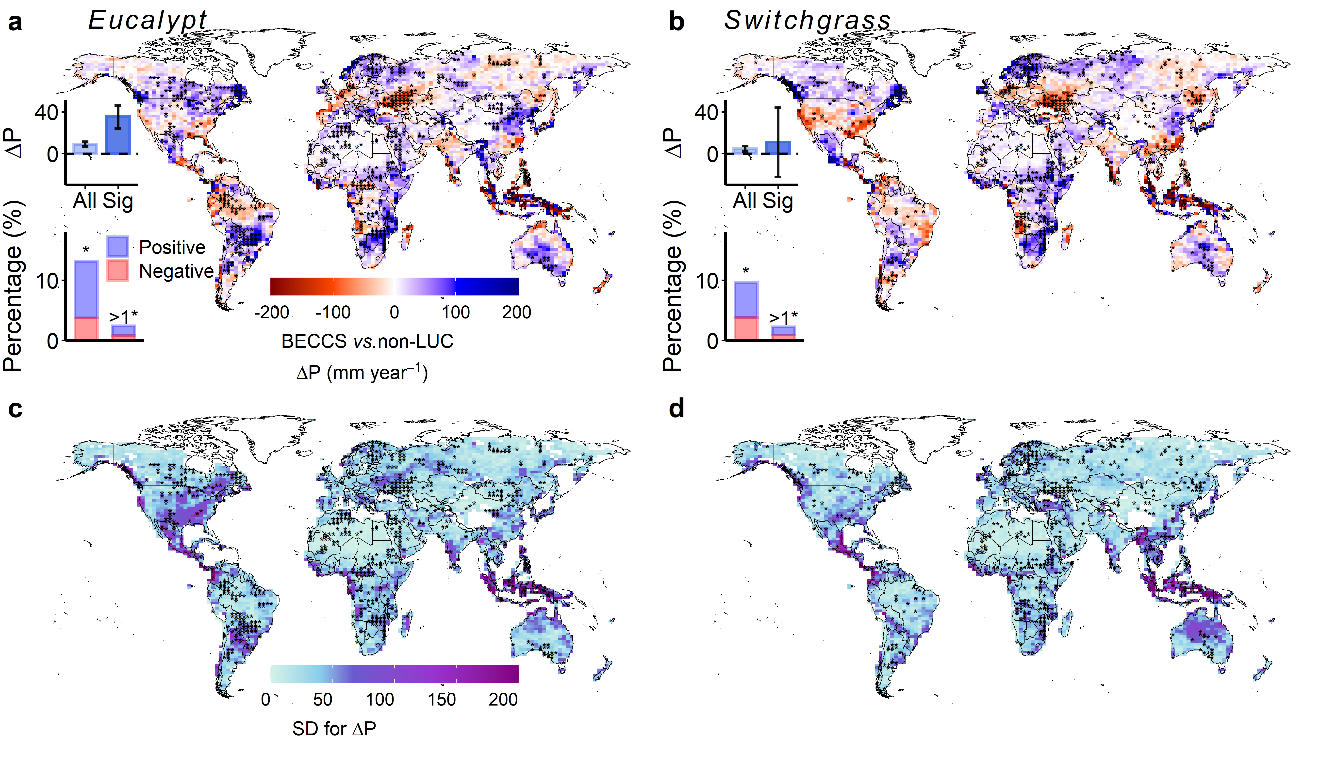Bioenergy with carbon capture and storage (BECCS) is one of the key negative emission technologies to achieve carbon neutrality and mitigate climate change. Bioenergy crops such as eucalypt and switchgrass can achieve carbon dioxide removal (CDR) by fixing CO2 into the biomass, then burning biomass and trapping CO2 in geological layers. However, there are still some limitations in the large-scale deployment of BECCS. For example, fast-growing bioenergy crops require a large amount of water and possibly aggravate water stress. Previous studies estimated the water demand of bioenergy crop growth but ignored the feedback of land surface biophysical changes on the terrestrial water cycle.
A research group from the Department of Earth System Science (DESS) at Tsinghua University conducted a modeling study on the feedback of large-scale bioenergy crop cultivation on the global terrestrial water cycle. This study also explored different cultivation strategies (i.e., different bioenergy crop types and different cultivation areas) and the biophysical impacts on the terrestrial water balance.
A dynamic vegetation model with a specific bioenergy crop module (ORCHIDEE MICT) coupled with a general circulation model (LMDZ) was used to simulate the biophysical characteristics and key hydrological variables in six bioenergy crop cultivation scenarios and one reference simulation. It was found that cultivation of eucalypt and switchgrass will increase the mean annual precipitation over global land by 9.0±2.4 mm year-1 and 4.7±2.7 mm year-1, respectively, and 15.5% and 11.9% of land areas show significant changes (Fig. 1). From the precipitation diagnosis based on the atmospheric water vapor budget equation, ET is the main source of precipitation increase in the eucalypt scenarios, while the increased precipitation results from both ET and moisture advection (Qadvt) in the switchgrass scenarios (Fig. 2). The increased precipitation and reduced runoff can partially offset the water consumption by the bioenergy crop growth. This study reveals the importance of the biophysical effects of land use change on the climate system and the terrestrial water cycle. Both the biogeochemical and biophysical effects of land-based climate mitigation measures should be comprehensively evaluated in order to formulate more effective climate change mitigation policies.
This study, titled “Increased precipitation over land due to climate feedback of large-scale bioenergy cultivation”, was published in Nature Communications. The first author of the paper is Dr. Zhao Li, and Associate Professor Wei Li is the corresponding author, both from DESS, Tsinghua University. Coauthors include Associate Professor Jonathon S. Wright, Associate Professor Wang Yong, Professor Lu Hui, Professor Huang Xiaomeng, Dr. Wang Jingmeng, Ph.D. candidates Liu Shu and Zhu Lei from DESS, Tsinghua University, Professor Philippe Ciais and Dr. Daniel S. Goll from the French Laboratory for Climate and Environmental Sciences (LSCE), and Professor Laurent Z.X. Li from the French National Centre for Scientific Research (CNRS). The research was supported by the National Natural Science Foundation, National Key Research and Development Program and Tsinghua University Initiative Scientific Research Program.

Fig. 1 Mean annual precipitation changes that would be caused by the large-scale cultivation of eucalypt and switchgrass. Black dots show the area with significant precipitation changes.

Fig. 2 Diagnosis of global terrestrial precipitation changes (ΔP: changes of precipitation; ΔET: changes of evapotranspiration; ΔQadvt: moisture advection; ΔQcnvg: moisture convergence; and Δε: the residuals).
Link to the paper: https://doi.org/10.1038/s41467-023-39803-9 .
Editor: Li Han

